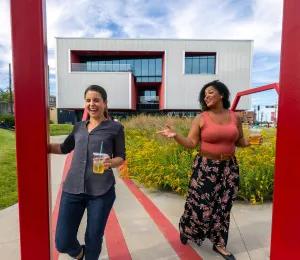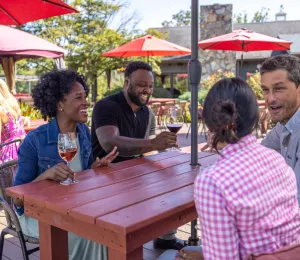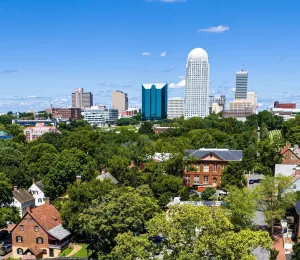A History of Our History Makers: Honoring Winston-Salem’s Black Pioneers
Known as a City of Arts and Innovation, Winston-Salem is no stranger to trailblazers, game changers, rule breakers, and history makers. In fact, our proud history of making history includes a number of notable achievements that extend far beyond our community. Join us as we celebrate just a few of the African American men and women whose achievements helped transform Winston-Salem, North Carolina, the nation, and the world.
George Black (1879 – 1980)
Master Brick Mason
The son of two former slaves, George Black arrived in Winston-Salem in 1889 at age 10 after walking nearly 50 miles from Randolph County (Asheboro) with his brother and father. Black immediately took a job at Hitchcock Brickyard. By the mid-1920s, Black had perfected the art of making his own signature, handmade Colonial-style Carolina red clay bricks. They were prized for artistry, quality, and unmatched durability, and quickly made Black the toast of the town. Wealthy clients, including city leaders, business tycoons, and tobacco magnate R.J. Reynolds himself soon bought bricks faster than George could make. In fact, Reynolds was so fascinated with the product that he reportedly ordered more than a million bricks in the construction of his tobacco factory.
As times changed and brickmaking became automated, Black remained true to his craft. He produced thousands of handmade bricks each day behind his home in East Winston-Salem, just outside of downtown, until Black was well into his 70s.
You can still spot Black’s signature handmade bricks throughout the south, including sidewalks in Old Salem, mansions in Winston-Salem’s historic Buena Vista, and restored historic properties in Virginia’s Colonial Williamsburg.
In the early 1970s, Black was featured on national television, invited to visit the White House by President Nixon, and traveled on a mission trip to Guyana to teach villagers how to make bricks by hand. George Black passed away in 1980 at the age of 101, having made bricks for more than eight decades. A bronze statue of him now stands outside the Forsyth County Government Center at the intersection of 2nd Avenue and Chestnut Street in downtown Winston-Salem.
You can see George Black’s bricks throughout Winston-Salem:
- Old Salem (specifically, the sidewalks, and Market Fire House)
- The Salem College Library
- The former Wells Fargo branch at 916 W. Fourth St.
- The former YWCA on Glade Street
- Latino Community Credit Union (658 Waughtown St.)
- Black-Phillips-Smith building (2301 N. Patterson Ave.)
- 235, 303, 700, and 1000 Arbor Road (private homes)
- 2560 and 2580 Warwick Road (private homes)
- 107 and 109 Dellabrook Road (private homes)
Dr. Simon Greene Atkins (1863 – 1934)
Founder and President of Winston-Salem State University
Born to farmers and former slaves in 1863 two years prior to the end of legalized slavery, Simon Greene Atkins was a precocious student who took nothing for granted. Atkins received his early education in Raleigh and by 1881 had founded the North Carolina Negro Teachers Association. In 1890, Atkins was offered the position of Principal of Depot Street School in Winston-Salem, which was the largest public grammar school for Black students in NC.
While there, Atkins began his work to improve living conditions for African Americans. In 1892, Dr. Atkins and his wife Oleona became the first settlers in the Winston-Salem neighborhood known as Columbian Heights. Atkins established a community that would serve as a “center of mutual understanding, respect, and regard of one race for the other.” The new area proved to be a suitable environment for a new school. In 1892, Atkins founded the Slater Industrial Academy in Columbian Heights, which by 1925 would be known as Winston-Salem Teachers College. Today, we know the community and school as the internationally recognized Winston-Salem State University, where Dr. Atkins served as president for more than 30 years (1892-1904 and 1913-1934).
Simon dedicated his life to improving education for African Americans. His prowess in teaching allowed him to make great strides in providing better and equal education. Through his teaching and indeed throughout his life, Atkins worked to better his community by improving the education, opportunities, housing, and economic status of the African American community. Simon married his sweetheart and helped raise nine children in Winston-Salem, one of whom would succeed him as President of Winston-Salem Teachers College in 1934.
Safe Bus Company
Largest Black Transportation Company in the World
In the mid 1920s, many people Winston-Salem relied on electric streetcars to travel to and from work. Trouble was, the streetcars only operated inside white neighborhoods. That means Black riders had to walk to and from those neighborhoods before catching their daily streetcar — a walk that often spanned several miles and could take hours.
Rather than reroute the streetcars, Jim Crow laws forced the creation of a second jitney system to transport workers to and from the existing streetcar stops. Of course, the jitneys were poorly regulated, dangerous to operate, and wildly overcrowded. To make matters worse, dozens of competing operations squabbled over territories, making daily travel an unsafe gamble for drivers and riders alike.
By 1926, a savvy group of jitney operators banded together to form a safer solution. Pooling their life savings, the group amassed enough to purchase $100,000 in shares of stock and form the Safe Bus Company with a fleet of 35 buses. Routes covered all parts of the city for a five-cent fare, enabling Black workers to travel to and from their jobs with convenience, security and ease.
Led by founders Harvey and Ralph Morgan, Joseph Miller, George Dillahunt, John Adams, George Ragsdale, Elliott Davis, Jefferson Hairston, C. T. Woodland, Charlie Peebles and Elijah Miller, the company thrived.
The Safe Bus Company was quickly named the largest Black-owned transportation company in the world.
By 1955, Safe Bus grossed $425,000, and had been profiled in both Ebony and Jet magazines. In 1959, Safe Bus named its first female president, Mary Burns, who led the company to even greater success. At its prime, the company carried 12,000 fares a day, grossed $10,000 a week and had 75 employees.
Our History of Makers Continues
Since its earliest days as a Moravian farming community to its pioneering leadership in education, commerce, craftsmanship, and the arts, Winston-Salem has a proud reputation for attracting — and creating — leaders in Black history. To learn more about our proud cultural heritage, view/download our African American Arts & Culture Guide here.






